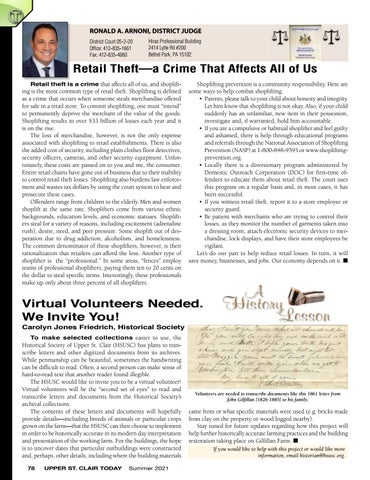RONALD A. ARNONI, DISTRICT JUDGE District Court 05-2-20 Office: 412-835-1661 Fax: 412-835-4060
Hiras Professional Building 2414 Lytle Rd #200 Bethel Park, PA 15102
Retail Theft—a Crime That Affects All of Us Retail theft is a crime that affects all of us, and shoplifting is the most common type of retail theft. Shoplifting is defined as a crime that occurs when someone steals merchandise offered for sale in a retail store. To commit shoplifting, one must “intend” to permanently deprive the merchant of the value of the goods. Shoplifting results in over $33 billion of losses each year and it is on the rise. The loss of merchandise, however, is not the only expense associated with shoplifting to retail establishments. There is also the added cost of security, including plain clothes floor detectives, security officers, cameras, and other security equipment. Unfortunately, these costs are passed on to you and me, the consumer. Entire retail chains have gone out of business due to their inability to control retail theft losses. Shoplifting also burdens law enforcement and wastes tax dollars by using the court system to hear and prosecute these cases. Offenders range from children to the elderly. Men and women shoplift at the same rate. Shoplifters come from various ethnic backgrounds, education levels, and economic statuses. Shoplifters steal for a variety of reasons, including excitement (adrenaline rush), desire, need, and peer pressure. Some shoplift out of desperation due to drug addiction, alcoholism, and homelessness. The common denominator of these shoplifters, however, is their rationalization that retailers can afford the loss. Another type of shoplifter is the “professional.” In some areas, “fences” employ teams of professional shoplifters, paying them ten to 20 cents on the dollar to steal specific items. Interestingly, these professionals make up only about three percent of all shoplifters.
Shoplifting prevention is a community responsibility. Here are some ways to help combat shoplifting. • Parents, please talk to your child about honesty and integrity. Let him know that shoplifting is not okay. Also, if your child suddenly has an unfamiliar, new item in their possession, investigate and, if warranted, hold him accountable. • If you are a compulsive or habitual shoplifter and feel guilty and ashamed, there is help through educational programs and referrals through the National Association of Shoplifting Prevention (NASP) at 1-800-848-9595 or www.shopliftingprevention.org. • Locally there is a diversionary program administered by Domestic Outreach Corporation (DOC) for first-time offenders to educate them about retail theft. The court uses this program on a regular basis and, in most cases, it has been successful. • If you witness retail theft, report it to a store employee or security guard. • Be patient with merchants who are trying to control their losses, as they monitor the number of garments taken into a dressing room, attach electronic security devices to merchandise, lock displays, and have their store employees be vigilant. Let’s do our part to help reduce retail losses. In turn, it will save money, businesses, and jobs. Our economy depends on it. n
Virtual Volunteers Needed. We Invite You! Carolyn Jones Friedrich, Historical Society To make selected collections easier to use, the Historical Society of Upper St. Clair (HSUSC) has plans to transcribe letters and other digitized documents from its archives. While penmanship can be beautiful, sometimes the handwriting can be difficult to read. Often, a second person can make sense of hard-to-read text that another reader found illegible. The HSUSC would like to invite you to be a virtual volunteer! Virtual volunteers will be the “second set of eyes” to read and transcribe letters and documents from the Historical Society’s archival collections. The contents of these letters and documents will hopefully provide details—including breeds of animals or particular crops grown on the farm—that the HSUSC can then choose to implement in order to be historically accurate in its modern day interpretation and presentation of the working farm. For the buildings, the hope is to uncover dates that particular outbuildings were constructed and, perhaps, other details, including where the building materials 78
UPPER ST. CLAIR TODAY
Summer 2021
Volunteers are needed to transcribe documents like this 1861 letter from John Gilfillan [1826-1885] to his family.
came from or what specific materials were used (e.g. bricks made from clay on the property or wood logged nearby). Stay tuned for future updates regarding how this project will help further historically accurate farming practices and the building restoration taking place on Gilfillan Farm. n If you would like to help with this project or would like more information, email historian@hsusc.org.
